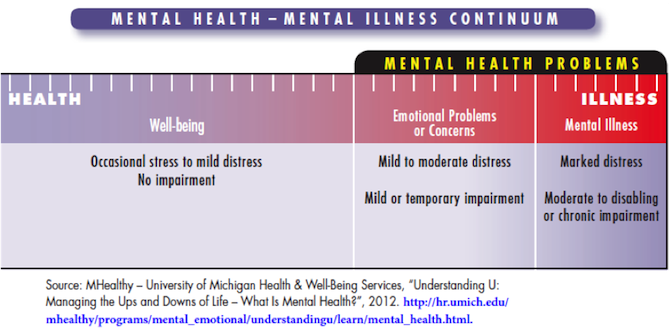What is Child and Youth Mental Health?
Mental Health is defined as a state of well-being in which every individual realizes his or her own potential, can cope with the normal stresses of life, can work productively and fruitfully, and is able to make a contribution to her or his community.1
Mental health problems:
- Are emotional, behavioural and brain-related difficulties that may have a negative impact on a student’s well-being;
- Interfere with the student’s functioning at school, at home, in the community, and in social settings;
- Affect the student’s development, school attendance, academic achievement, and relationships with family and friends.
A mental health problem that is severe, persistent, and causes impairment in daily life is called a mental health disorder or mental illness. It is helpful to think of mental health as occurring along a continuum.

How Common are Child and Youth Mental Health Problems?
Most estimates place the rate of mental health problems at about 18-23% of the student population. An easy way to remember how many students are affected by significant emotional difficulties is the “one in five” statistic. This means that in any given classroom of 25-30 students, there may be 5 to 7 students who struggle with behaviour and emotions to a degree that will interfere with their academic performance.
What do Mental Health Problems Look Like?
Mental health problems vary greatly in how they look. A useful way of thinking about them is to divide symptoms into two broad areas:
- externalizing problems, or behaviours like aggression, impulsivity, and non-compliance, and;
- internalizing problems, or emotional states like sadness and anxiety and behaviours like social withdrawal.
Although organizing the clusters of symptoms is useful, in real life mental health problems do not fall neatly into specific categories. Often symptoms that are associated with one disorder are also symptoms of other disorders, and, to complicate things further, disorders tend to travel together. This is called co-morbidity. Approximately 45% of children and youth with one mental health disorder are likely to have another area of difficulty as well (e.g., depression AND anxiety, ADHD AND oppositional defiant disorder).
Given how complex mental disorders are, in Ontario the only professionals who are qualified to diagnose mental health problems are physicians (including psychiatrists) and psychologists. School boards may have mental health professionals on staff who can diagnose, but many communities require a referral to children and youth mental health services.
What Mental Health Problems Are Most Likely Seen at School?
Some child and youth mental health problems are more common than others. Specifically, difficulties with anxiety, behaviour, and mood are most prevalent amongst Canadian children. Within the school context, teachers often notice emotional and behavioural difficulties associated with learning.
Within the school context, teachers are able to observe students consistently over an extended period of time. As well, they ‘see’ students in the context of other students. As such, teachers are in a unique position to notice emotional and behavioural difficulties associated with learning, and to notice when there are changes in a student’s behaviours.
Following is a list of specific student behaviours which teachers may notice and which might indicate the presence of mental health difficulties:
- social isolation
- inattention
- weak social skills
- strong emotional reactivity
- aggression
- hyperactivity /impulsivity
- poor frustration tolerance
- changes in behaviour or mood
Other general signs that a student may be struggling are when the student’s emotions and behaviour are not age appropriate, the behaviour is dramatically different from that of the student’s peers, and the duration of the behaviour appears to be excessive.
Because some mental health difficulties occur at different times in a student’s development, some types of problems are more commonly seen in primary, junior and intermediate settings, while others are most prevalent within secondary schools. Untreated problems can become more pronounced over time, and, as a result, secondary school educators are more likely to observe more serious mental health difficulties amongst students than elementary school educators. Secondary school personnel in particular, should be alert to the potential role of addictions in student emotions and behaviour at school.
Adapted from: Leading Mentally Healthy Schools: A Resource for School Administrators (School Mental Health – ASSIST, 2013) and Supporting Minds: An Educator’s Guide to Promoting Students’ Mental Health and Well-Being (Ontario Ministry of Education, 2013)
Notes
1 World Health Organization http://www.who.int/features/factfiles/mental_health/en
